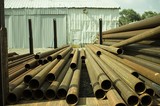A Light Hearted View of Pipe Specifications for those not in the Pipeline Industry
- All pipe is to be made of a long hole surrounded by metal or plastic centered around the hole.
- All pipe is to be hollow throughout the entire length – do not use holes of different length to the pipe.
- The ID {inside diameter} of all pipe must not exceed the OD {outside diameter} – otherwise the hole will be on the outside.
- All pipe is to be supplied with nothing in the hole, so that water, steam or other stuff can be put inside at a later date.
- All pipe should be supplied without rust; this can be more readily applied at the job site.
- NOTE: Some vendors are now able to supply pre-rusted pipes. If available in your area, this product is recommended as it will save a great deal of time at the job site.
- All pipe over 500ft [150m] in length should have the words “LONG PIPE” clearly painted on each side and end so that the contractor knows it is a long pipe.
- Pipe over 2 miles [3.2Km] in length must also have the words “LONG PIPE” painted in the middle so the contractor will not have to walk the entire length of the pipe to determine whether or not it is a long pipe or a short one.
- All pipe over 6ft [1.83m] in diameter must have the words “LARGE PIPE” painted on it, so the contractor will not mistake it for small pipe
- Flanges must be used on all pipe. Flanges must have holes for bolts, quite separate from the big hole in the middle
- When ordering 90 or 30 degree elbows, be sure to specify left-hand or right-hand otherwise you will end up going the wrong way
- Be sure to specify to your vendor whether you want level, uphill or downhill pipe. If you use downhill pipes for going uphill the water will flow the wrong way
- All couplings should have either right-hand or left-hand threads, but do not mix the threads otherwise as the coupling is being screwed on one pipe it is being unscrewed from the other
- All pipes shorter than 1/8 [3mm] are very uneconomical in use requiring many joints. They are generally known as washers.
- Joints in pipes for piping water must be water tight. Those in pipes for compressed air however need only be air tight
- Lengths of pipes may be welded or soldered together. This method is not recommended for concrete or earthenware pipes
- Other commodities are often confused with pipes. These include: conduit, tube, tunnel and drain. Use only genuine pipes.
Pipe
(An alternative view, courtesy of Wikipedia).
A pipe is a tubular section or hollow cylinder, usually but not necessarily of circular cross-section, used mainly to convey substances which can flow — liquids and gases (fluids), slurries, powders, masses of small solids. It can also be used for structural applications; hollow pipe is far stiffer per unit weight than solid members.

Beer Pipeline
Bars in the Veltins-Arena, a major football ground in Gelsenkirchen, Germany, are interconnected by a 5 km long beer pipeline.
Thor Pipeline Beer (photo by Arseny Chernov) In Randers city in Denmark, the so-called Thor beer pipeline was built. Originally copper pipes ran directly from the brewery and, when in the 90’s the brewery moved out of the city, Thor beer replaced it as a source with a giant tank.

Pipeline
Liquids and gases are transported in pipelines. Substances include sewage, slurry, water, beer and notably crude petroleum and refined petroleum product including fuels: oil, natural gas, and biofuels.
